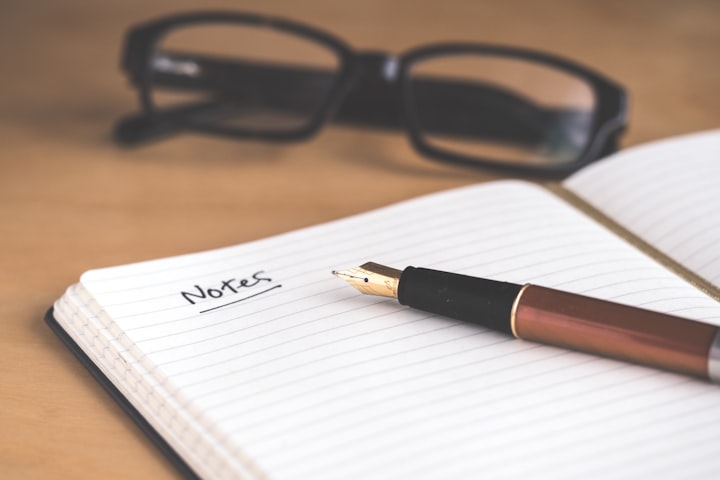Notetaking tips to improve your creativity
How the simple act of taking notes can be the means to driving more creativity in every area of life.

(AI was used to assist in creating this post)
You likely think of notetaking as a simple task that anyone can do.
Traditionally, notetaking is linear and focuses on capturing facts and key points as they’re spoken.
While this works fine for recording lecture content, the method is too passive and doesn’t engage creative thinking or foster original ideas. (Yes, it’s possible for notetaking to be creative.)
Changing your note-taking approach can enhance creativity and maximize your learning. And you don’t need notetaking skills for just studying, you can apply it work, for language learning, and use it all your life.
We’re going to look at switching from linear note-taking to multidimensional mapping. This boosts your lateral thinking and creativity. You’ll be empowered to engage with content on a deeper level.
You’ll remember material better, so that you get those lightbulb moments of inspiration that drive creativity more often. Let’s look at different ways to use notetaking for better thinking!
1. Mind Mapping
Mind mapping is a powerful notetaking technique that promotes creative thinking and enhanced learning outcomes.
Mind maps use a radiant, nonlinear format where you organize key concepts in webs that branch out from a central idea. You can use it to organize a book idea, to come up with a customer journey map, game design concept, and more!
It appears that mind mapping taps into your brain's natural preference for visual learning and spatial organization. As such, this allows you to see the relationships between concepts more clearly.
By identifying relationships you may not have noticed otherwise, mind mapping empowers you to synthesize information and generate new insights.
Another benefit of mind mapping is that it engages both hemispheres of your brain. The logical left side is activated through the structured organization of concepts, while the creative right side is stimulated by the visual expression and mental exploration involved in mind mapping. This whole brain engagement boosts your understanding, comprehension, and retention of any material.
2. Visual Notetaking
Incorporating visual elements into your notes can be a great way to boost creativity.
Doodling, drawing diagrams, and adding illustrations engage the visual learning system. This not only makes notetaking more dynamic and fun, but it can also help improve focus and retention of the material.
The visual cortex is closely linked to creativity, imagination, and idea generation. By drawing and sketching concepts during a lecture or meeting, you activate this visual center of the brain. This gets your creative juices flowing, sparking new neural connections.
Visual elements also allow you to capture certain concepts or relationships that may be difficult to convey with just text.
For example, drawing a quick diagram of a process being explained allows you to visualize the steps and how they connect. Using symbols, arrows, and sketches to represent relationships described in a lecture can help cement that knowledge. The visual version in your notes provides an additional memory trigger.
So, don't be afraid to incorporate doodles and drawings into your note-taking. Let your creativity flourish as you capture information visually. This boost in engagement, focus, and retention will serve your learning and comprehension.
Today, many online courses are available, offering visual notetaking as a skill. It's even something that you can use at work to record meetings and conceptualize difficult processes.
3. Digital Tools
Online mind-mapping tools like Coggle allow you to easily create and organize visual notes. The flexibility to drag, connect, and restructure nodes promotes innovative thinking and allows you to share maps and visual knowledge with others easily.
Tablets with stylus input are another great option for notetaking. The ability to draw, scribble, insert images, and record audio annotations directly into your notes fosters creativity. Apps like GoodNotes and Notability offer powerful features for dynamic notetaking.
Audio recording lectures or meetings while taking written notes is another helpful digital technique. This allows you to revisit key moments and retain more context. Apps like Otter.ai even generate transcripts automatically from recordings to support your notes.
The key is leveraging technology in ways that feel natural and liberating. Digital notetaking tools remove friction and expand possibilities for capturing information.
4. Color Coding
Using different colors for your notes is a fantastic trick to spark some creativity and make learning a bit more fun. You can use highlighters, color pens, and sketch pens to help you add color to your physical notetaking.
By assigning different colors to represent specific topics, themes, or categories, you can better organize and structure the information visually. This color association helps your brain to process and synthesize ideas more efficiently.
For example, you could use blue for key themes, red for important facts or statistics, grey for concepts you're struggling with, and so on. The vibrant colors will help you quickly scan your notes later and identify the most relevant or noteworthy sections.
The important thing is to be consistent with whatever color coding system you establish. Use the same colors repeatedly to represent the same types of information. This consistency is what really amplifies the effectiveness of color coding for memory and creative thinking.
5. Notetaking Doodle Breaks
Taking short creative doodle breaks while notetaking can be an excellent way to re-engage your mind, boost focus, and make unexpected connections. Even just 30 seconds of doodling in the margins or drawing simple shapes and images related to the material can give your brain a chance to process the information in new and innovative ways.
Doodling activates different parts of your brain, allowing you to approach the content from alternate perspectives. The physical act of doodling also keeps you engaged in the note-taking process. It's easy for our minds to wander during long lectures or study sessions, but quick doodle breaks let you tap back into your creative side.
So, next time you're taking notes, don't be afraid to incorporate some doodles. Let your mind wander and make unexpected connections. Those simple doodles might just unlock your inner genius.
6. Conversational Notetaking
With this technique, you annotate conversations in real-time to capture key insights, interesting ideas, and important details.
Rather than trying to transcribe a conversation word-for-word, focus on jotting down the main points and highlights. Use symbols, abbreviations, mind maps, or visual elements to quickly note relationships between topics and concepts brought up.
Conversational note-taking requires active listening and quick thinking to determine the most relevant details to write down. By annotating discussions as they happen, you can refer back to these notes later for reflection and review.
The act of real-time note-jotting also keeps you engaged in the discussion, rather than passively listening. You'll find yourself paying closer attention when you know you need to capture important points. Reviewing your annotated conversations is like re-living the discussion and gaining a new perspective.
7. Personalized Shorthand
Developing your own shorthand system of abbreviations, symbols, and visual cues can be a great way to boost engagement and synthesis when taking notes.
The act of creating personalized shorthand requires you to actively think about the key ideas or concepts you want to capture. This process enhances understanding as you determine the most concise ways to represent information.
You also develop greater fluency in your note-taking, making it easier to keep up with course lectures or meetings. The shortcuts you invent also help reinforce learning since translating your own shorthand engages memory and connects you more deeply to the material.
Some tips for creating effective personalized shorthand:
- Use abbreviations for common words like "because" (bc) or "example" (ex).
- Substitute symbols for concepts, like a lightbulb for ideas.
- Create visual symbols that connect to key terms, like drawing a scale for "justice."
- Color code topics or categories with different highlighters.
- Make up acronyms for longer phrases or concepts.
The goal is to design a shorthand system tailored to how your mind works. With personalized symbols and shortcuts, you can take notes more creatively in a way that sticks with you.
8. Sharing and Collaborating
Sharing your notes with others can help generate new ideas and perspectives. When we get stuck in our own thinking patterns, gaining an outside viewpoint can stimulate creativity.
Consider sharing notes with a study group or posting them online to get feedback from a broader community. The feedback process alone can spark new insights.
Online collaborative platforms like Google Docs also enable real-time brainstorming and notetaking with others. Being able to simultaneously add ideas, comment, and rearrange content fosters creative thinking. This opens you up to build on each other's perspectives, make connections you may not have spotted alone, and gain a more holistic understanding of the material. Plus, collaborating online builds digital literacy skills that are valuable now.
Conclusion
Overall, notetaking doesn't have to be a boring school habit. I can be an actual skill you get paid for if you build your skills in it, do certifications, and use in work settings to map work processes or generate ideas.
Try out the different methods shared here and combine them to be a more creative person today!
About the Creator
Syed Balkhi
Syed Balkhi is the founder of WPBeginner, the largest free WordPress resource site. You can learn more about Syed and his portfolio of companies by following him on his social media networks.






Comments (1)
Great tips!